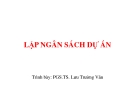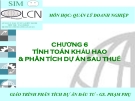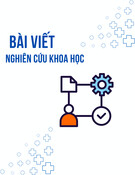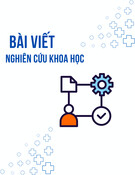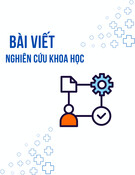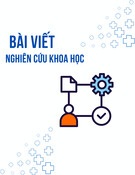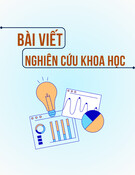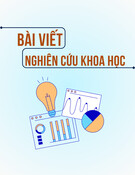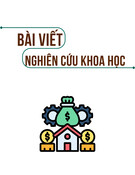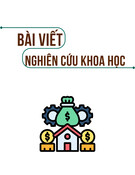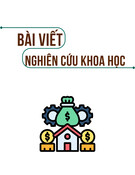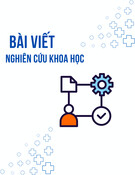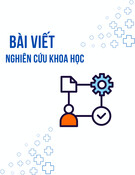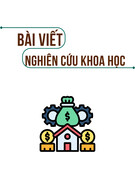
44
Limitations of the lump-sum package contract policy…
LIMITATIONS OF THE LUMP-SUM PACKAGE CONTRACT
POLICY IN IMPLEMENTATION OF SCIENTIFIC AND
TECHNOLOGICAL TASKS FUNDED BY STATE BUDGET
M.Sc. Pham Thi Hien
Department of Science and Technology, Thai Nguyen Province
Abstract:
The funding modality of package contract to perform scientific and technological (S&T)
tasks has currently not supported for effective management of financial resources for
implementation of research projects, not created an enabling environment for scientists,
thus it does not really promote scientific research. This article focuses on limitations of the
package contract policy and its impact on the implementation of S&T tasks funded by State
budget, and suggests direction for improving the policy.
Keywords: Lump-sum package funding policy; S&T tasks.
Code: 13082601
1. Theoretical and practical basis of lump-sum package contract in
performing state scientific and technological tasks
1.1. Some concepts
- Scientific and technological task is a set of scientific and technological
issues need to be addressed, implemented in the form of S&T theme,
project, program. Each form has its different purposes.
- Product of research and development activity: In all cases, the product
of research and development activities is information, regardless it is of
natural sciences, social sciences or science and technology.
- S&T Policy is a set of measures that management can utilize it to
impact on managed objects (e.g, S&T organizations) to achieve the
objectives setforth for a certain period.
- Lump-sum package funding policy in implementation of research
theme/project is one of the S&T policies. It is a measure issued by the
S&T management and used as a tool to manage research
themes/projects.
- Lump-sum package funding: In this article this concept only applies for
the implementation of research themes/projects. In this context, it

JSTPM Vol 2, No 2, 2013 45
means funding for the implementation of research theme/project is
provided by the management body to the project owner as a lump-sum
package based on the research content and total cost estimates which
have been approved by approving authorities (following the
recommendations of a Technical Review Council after assessing the
content and expected results stated in the application); the product of
research here is the results evaluated by a Acceptance Council of
Scientists).
1.2. Why is lump-sum package funding?
When considering this modality, we should look at two sides with different
controversial thoughts: One side of financial managers and the other side of
scientists (specifically, project managers who represent research team
consisting of scientists involved in research theme/project). From financial
managers’ perspective, there should always take all kinds of measures to
make sure the State financial sources are well managed, spendings are
closely controlled. After being disbursed the recipient must have sufficient
invoices and vouchers for financial clearance. On the scientists’ opinions,
because of specific features of scientific activity it is difficult to know
beforehand exact cost of research materials due to price fluctuation, therefore
scientists find it difficult, restrictive in implementation of research tasks when
applying the current financial mechanism. Therefore, it is necessary to have a
proper management mechanism that can satisfy both sides.
Thus, the lump-sum package funding policy should aim at achieving two
goals:
- Effectively manage the State budget allocated for science;
- Create a favorable mechanism for scientists when they use this kind of
fund. Intellectual products must be paid at satisfactory level.
1.3. Basis for calculation of the lump-sum funding for science and
technology activities
The basis for estimation of budget of research theme/project under the
package funding modality includes the following factors:
1.3.1. Identify issues to be studied and research activities to be carried out
in the research theme/ project
This is very important task, it is often handled by leading experts in the area
of concern or reputable scientists. In the proposal, research managers are
requested to describe/explain the content of research need to be carried out
and the expected outputs to be produced by the research project. The

46
Limitations of the lump-sum package contract policy…
decision to approve or reject funding for the proposal will be based on the
recommendations of the Evaluation Council after a care full assessment on
the need and specific content of the project.
1.3.2. Determine the total funding required to ensure smooth
implementation of research activities including: remuneration for scientific
labor, materials, energy for research.
In order to calculate the total cost of the research theme/project in a most
practical manner, it requires joint effort, cooperation from both sides:
project owner and funding agency.
Normally, the estimation for the production butget is based on the economic
and technical cost norms issued by Goverment and the price is determined in
according to present market price, including: cost norms for labor, materials,
energy, etc. However, the bugeting for scientific and technological tasks, or
more specifically, research themes/projects has its own characteristics, unlike
other types of physical production activity, so it is not easy to estimate costs
close to the actual implementation. Currently, there is no document of the
State stipulated provisions of detailed remuneration for research activities.
Scientists find themselves sometimes difficult to estimate in advance their
level of effort and time to achieve the desired results.
Therefore, it is not an easy task to estimate the total budget of a research
project in a most realistic way, only 80% of the real requirement. In the
research process, scientists have to adjust the budget to scope with changes
of work items to obtain expected results as quickly as possible. Results of
the study below showed that the most difficult stage in estimation of budget
for scientific research is labor cost as scientific labor has its own
characteristics [15], thus requiring a proper level of flexibility in budgeting
and approving the budget for research so as that financial matters are not the
biggest barrier affecting the research quality.
During 2001 - 2007, the basis for the cost estimates of research project was
mainly based on the provisions in Circular 45/2001/TTLT/BTC-
BKHCNMT, dated 18/6/2001 (Circular 45). The issuance of a frame of
payments for research as stipulated in Circular 45 had the purpose of
creating more autonomy for project managers in implementing research
activities. However, the ceiling limit of rates is too low, it makes researchers
go around to apply the rules. For example, in the field of social sciences and
humanities [15, page 54], there are projects with large research content,
require interdisciplinary efforts. To get the budget approved, the large
project has to split into smaller separate thematic subjects with smaller
budget each for ease of clearance. Other case when a study requires highly

JSTPM Vol 2, No 2, 2013 47
qualified and experienced personnel in the field of research, but the budget
does not allow project owner to engage such kind of experts/specialists. On
the other hand, rigid rules of the cost norms frame made it difficult to use
and affected the progress and quality of research.
Since 2007, Circular 45 has been replaced by interministerial Circular No.
44/2007/TTLT/BTC-BKHCN dated 07/5/2007 (Circular 44) issued by
Ministry of Finance and Ministry of Science and Technology guiding
norms, methodology of buget allocation and estimation for S&T projects
funded by state budget.
According to the content of Circular 44, funding for the implementation
research project activities is itemized as follows: Development of detailed
proposal; Thematic studies (including thematic type 1 and type 2); Report
on desk study; Development of survey questionairs ; Information supply ;
Survey report, including data analysis ; Scientific report; Consultants for
evaluation, acceptance panels at the grassroots level; Scientific workshop;
Remuneration for project management; S&T management fee.
Remuneration for research is mainly undertaken in the form of payment by
topic to the head of the research theme, this means project owner has to split
the project into research thematic thems to effect the remuneration for
research activities.
In addition, project owner needs to use a number of reference documents
with special features that are not defined in the Circular as basis for making
estimate costs.
Though there was improvement in the cost norms framework for research
activities specified in Circular 44, namely higher ceiling rates, it has not
fundamentally solved the problem of reasonable labor cost in scientific
research. The reason is because of currency devaluation (in 2001, the
inflation rate was 0.8%, but in 2007, it was 11.2%), if compared to the
minimum wage (in 2001, it was VND 210,000 and in 2007 it increased to
VND 450,000). We can see the increase of norms is still not satisfactory.
Thus, we can make a general statement that scientists are not satisfied with
the current remuneration system provided by research projects. According
to the results of a research project [15], the setting remuneration level for
scientific workers is lack of justifications. Payment for remuneration varies,
depending on types of implementing agency whether it is government
funded or not, if so, researchers can be paid out from projects besides
getting regular salary as government staff. Remunerations are also different
in different types of research project whether it is in the field of social
sciences and humanities or in the area of science and technology.

48
Limitations of the lump-sum package contract policy…
1.3.3. Correct evaluation of the research results compared to established
indicators
This work is no less important. Currently this is done by the method of
council meetings. The Evaluation Council consists of invited scientists with
intensive knowledge in the field of concern to participate in the assessment
(or acceptance) of the research results. However, it comes back to the issue
of remuneration for evaluators: In the previous Circular 45, the maximum
rate for analysis and evaluation was VND150,000-300,000/application; The
present Circular 44 provides higher level (VND 800,000/application). To do
analysis and evaluation, experts have to look at the whole implementation
process of the project, the review criteria again the content in research
proposals, consider the research results, it is just talking about desk
assessment. In case the research project of application nature evaluators
must go further to field assessment. Therefore, the remuneration stipulated
in such regulations is considered not satisfactory. Furthermore, no
provisions to prevent evaluators from low quality/wrong assessment, even
infringement they made in the evaluation of the projects
Thus, it is necessary to set up more specific procedures for the screening,
selection of projects and the evaluation of the project results, i.e.:
- There should be a clear mechanism: satisfactory remuneration, good
selection and evaluation criteria;
- There should also be strong sanction measures to prevent low
quality/wrong/underestimated assessment in the appraisal, selection and
evaluation of research projects. This is the key reason causing large
losses and wastes in S&T activities, in general and in research and
development, in particular.
One of the mandatory requirements of the package funding modality is
result based management, focus should be placed on job effectiveness, clear
set of evaluation criteria, otherwise, we can not say we have the modality in
place. Moreover, one of the basic principles of "lump-sum contract" is to
know the average consumption level of society for a particular job or to
value/price the average labor effort paid for it, only then we can determine
the lump-sum level for each job [13].
Financial mechanism is a system of modalities, methods, measures and
organizations to manage the process from creation - distribution - use of
financial resources in the national economy. Depending on specific context
and socio-economic development policy in each period, the financial
management mechanism is accordingly developed to be appropriate and
adaptive to economic mechanism of that period. In the market economy, it




